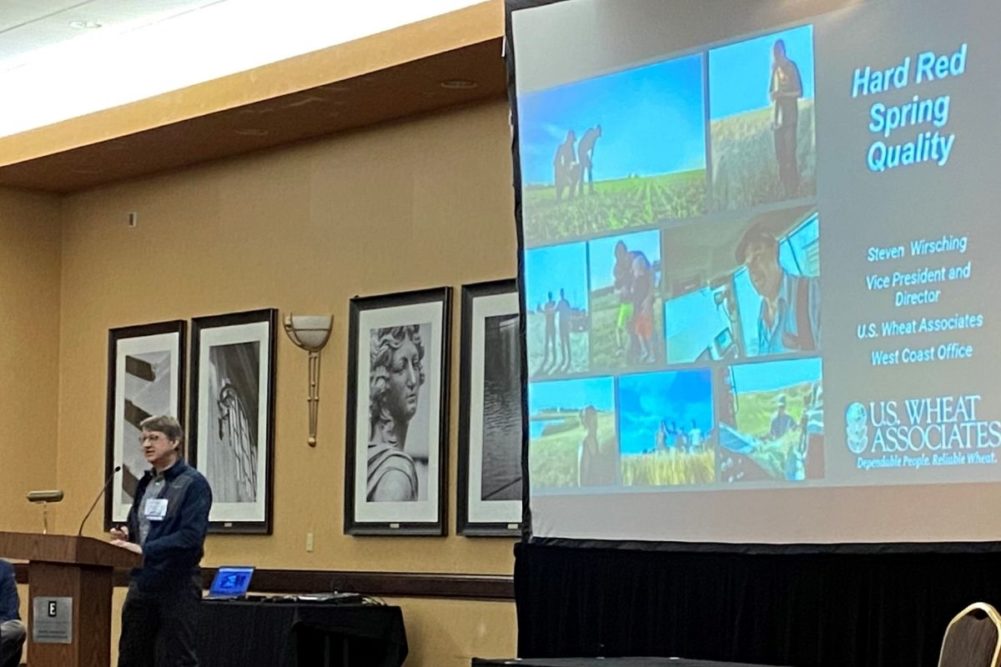KANSAS CITY, MISSOURI, US — Wheat experts from stakeholder industries and organizations gave presentations about the importance of achieving high quality as well as high yields in wheat at the Wheat Quality Council’s (WQC) annual meeting held Feb. 23 in Kansas City.
Historically, wheat farmers primarily have focused on yield. Maximizing production makes economic sense, but higher yields may come at a price. Steve Wirsching, vice president and director of West Coast offices at US Wheat Associates, said the United States will need to continue to improve the quality of its wheat in order to maintain its position as a key player in global markets. Wirsching said half of US wheat currently is exported. That percentage is likely to increase given world demand, geopolitical pressures, and the recent Russian invasion of Ukraine, both major global wheat exporters. But to benefit from expanding world demand, the United States faces competition from other countries such as Canada, which has been able to offer wheat with better quality without sacrificing yields.
A wheat quality deemed very important is protein content. Unfortunately, it is often the case higher-yielding wheat may have lower protein content making it less suitable for many baking applications. Also, as yields increase, wheat’s water absorption levels often tend to decrease, which may affect its overall value to millers and bakers, who would prefer high-moisture-absorbing wheat flour. But does improving quality mean sacrificing yields?
Growing wheat is often challenging, but adverse environmental conditions during recent years have made the venture even more so. Extreme drought and sometimes hurricane-force winds without rain to relieve parched fields have ravaged the nation’s hard red winter wheat growing regions.
Justin Gilpin, chief executive officer of Kansas Wheat, said 85% to 90% of hard red winter wheat currently is growing under drought conditions, based on the US Department of Agriculture’s analysis of data contained in the US Drought Monitor. Gilpin said the USDA in its February 2022 summary report on Crop Progress and Condition for Kansas reported 26% of the state’s wheat crop was in good to excellent condition as of Feb. 22, compared with 30% in January. The USDA also said only 9% of Oklahoma’s wheat crop was rated good to excellent. Most wheat crops across the hard winter wheat belt were rated poor to very poor, Gilpin said. At the same time, Gilpin suggested that the winter wheat surviving the drought was doing so because of its quality, proving that plant breeders’ investments have been worth the effort.
It was a bright spot for a crop that had been diminishing in planted area over the past few decades. In the 2020 growing season, the United States saw the lowest planted area of all-wheat, at 44.45 million acres, since such records began to be gathered in 1919. Area increased to 46.7 million acres for 2021, and due to expanding global demand, the USDA recently forecast all-wheat acreage to rise again in 2022 to 48 million acres. Producers and wheat users alike were hopeful 2020 saw the lowest wheat acreage.
Several programs exist to help farmers maximize their wheat’s quality as well as its yield. One of the most recognized programs is the annual National Wheat Yield Contest, which is coordinated by the National Wheat Foundation. And while the word “quality” is missing from that title, it is certainly a component of the contest, said Gilpin. Trying to bridge the gap between wheat producers and users, the contest now aims to recognize high-yielding and industry-desired high-quality wheat.
Another initiative dedicated to helping farmers produce high-quality wheat with high yields is the Kansas Wheat Rx program. This program, a partnership between Kansas Wheat and Kansas State University Research and Extension, researches strategies for producing high-yielding and high-quality wheat. Kansas Wheat’s Aaron Harries and K-State Research and Extension agronomist Romulo Lollato shared their insights and research from the collaborative program. They said Kansas Wheat Rx’s focus is to help producers identify the best wheat varieties for their specific environment and production practices.
For centuries, wheat has fed the world. Ensuring strong and high-quality varieties through modern plant breeding along with maximizing yield potential will sustain wheat’s role in feeding future generations.




